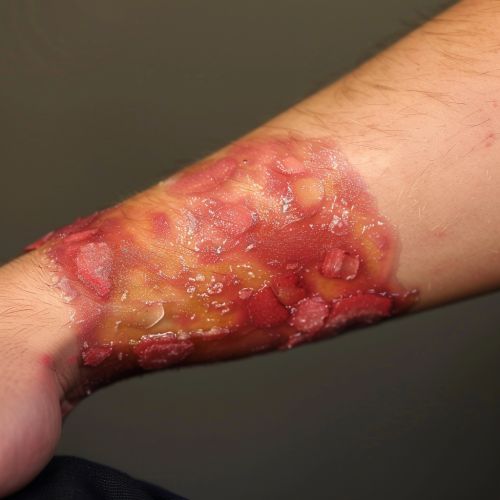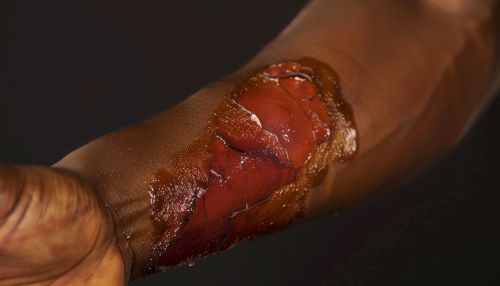Second-Degree Burn
Introduction
A second-degree burn, also known as a partial-thickness burn, is a type of burn injury that affects both the epidermis and the dermis, the outer and underlying layers of the skin. This type of burn is more severe than a first-degree burn, which only affects the epidermis, but less severe than a third-degree burn, which extends through the dermis and affects deeper tissues. Second-degree burns are characterized by blistering, severe pain, and potential scarring.
Pathophysiology
Second-degree burns result from damage to the skin caused by heat, chemicals, electricity, radiation, or friction. The injury leads to the destruction of the epidermis and varying degrees of damage to the dermis. This damage disrupts the skin's barrier function, leading to fluid loss, increased risk of infection, and impaired thermoregulation.
The pathophysiological response to a second-degree burn involves several stages:
- **Inflammation**: Immediately after the injury, the body initiates an inflammatory response to limit damage and begin the healing process. This includes vasodilation, increased vascular permeability, and the recruitment of immune cells to the site of injury.
- **Blister Formation**: The separation of the epidermis from the dermis leads to the formation of fluid-filled blisters. These blisters serve to protect the underlying tissue from further damage and infection.
- **Healing**: The healing process involves re-epithelialization, where new skin cells proliferate and migrate to cover the wound, and the formation of granulation tissue, which provides a scaffold for new tissue growth.
Clinical Presentation
Second-degree burns are typically characterized by:
- **Blisters**: Fluid-filled blisters are a hallmark of second-degree burns. These blisters may be intact or ruptured, exposing the underlying dermis.
- **Redness and Swelling**: The affected area is usually red, swollen, and painful due to the inflammatory response.
- **Moist Appearance**: The exposed dermis often appears moist and may ooze clear or yellowish fluid.
- **Pain**: Second-degree burns are usually very painful due to the involvement of nerve endings in the dermis.


Diagnosis
The diagnosis of a second-degree burn is primarily clinical, based on the appearance of the burn and the patient's history. Key diagnostic features include:
- **History of Burn Injury**: Information about the cause, duration, and circumstances of the burn is essential for diagnosis.
- **Physical Examination**: A thorough examination of the burn, including its size, depth, and location, is critical. The presence of blisters, redness, and pain helps differentiate second-degree burns from other types of burns.
- **Burn Depth Assessment**: Various methods, such as the use of a dermatoscope or laser Doppler imaging, can help assess the depth of the burn and guide treatment decisions.
Treatment
The treatment of second-degree burns aims to promote healing, prevent infection, and minimize scarring. Key components of treatment include:
- **Wound Care**: Proper wound care is essential for second-degree burns. This includes cleaning the wound, debriding dead tissue, and applying appropriate dressings. Silver sulfadiazine cream or other topical antimicrobial agents may be used to prevent infection.
- **Pain Management**: Pain control is a critical aspect of burn treatment. Analgesics, such as acetaminophen or nonsteroidal anti-inflammatory drugs (NSAIDs), are commonly used. Severe pain may require opioid analgesics.
- **Fluid Resuscitation**: In cases of extensive burns, fluid resuscitation may be necessary to prevent dehydration and maintain adequate blood volume.
- **Tetanus Prophylaxis**: Tetanus immunization should be updated in patients with burn injuries, as burns can provide an entry point for tetanus bacteria.
- **Physical Therapy**: Physical therapy and occupational therapy may be needed to maintain range of motion and prevent contractures during the healing process.
Complications
Second-degree burns can lead to several complications, including:
- **Infection**: The loss of the skin barrier increases the risk of bacterial infection. Signs of infection include increased redness, swelling, pus, and fever.
- **Scarring**: Second-degree burns can result in hypertrophic scars or keloids, which are raised, thickened areas of scar tissue.
- **Contractures**: Burns over joints can lead to contractures, where the skin and underlying tissues tighten, restricting movement.
- **Psychological Impact**: Burn injuries can have a significant psychological impact, leading to anxiety, depression, and post-traumatic stress disorder (PTSD).
Prognosis
The prognosis for second-degree burns depends on several factors, including the size and location of the burn, the patient's age and overall health, and the promptness and quality of treatment. Most second-degree burns heal within two to three weeks with appropriate care. However, larger or deeper burns may take longer to heal and may result in more significant scarring.
Prevention
Preventing second-degree burns involves reducing exposure to common burn hazards and implementing safety measures. Key prevention strategies include:
- **Fire Safety**: Installing smoke detectors, using fire-resistant materials, and practicing fire safety drills can reduce the risk of burns from fires.
- **Safe Cooking Practices**: Using caution when cooking, keeping hot liquids out of reach of children, and avoiding loose clothing near open flames can prevent burns in the kitchen.
- **Chemical Safety**: Proper handling and storage of chemicals, using protective equipment, and following safety guidelines can prevent chemical burns.
- **Sun Protection**: Using sunscreen, wearing protective clothing, and avoiding excessive sun exposure can prevent sunburns, which can progress to second-degree burns.
